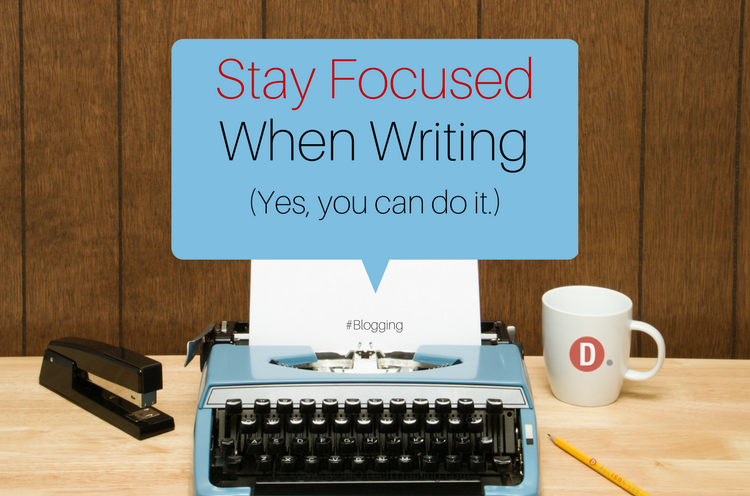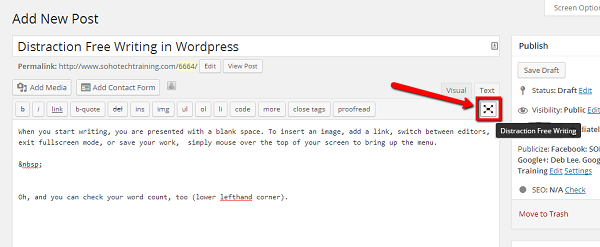Being productive when you don’t feel like it? Yeah, that’s tricky. You're not always going…

8 Ways to Stay Focused When Writing a Blog Post
Blogging can be a fun, interesting, entertaining, helpful, and fabulous experience for both bloggers and their readers. But, what blogging often isn’t is quick. It’s usually not a done-in-a-jiffy type of activity. It requires the ability to stay focused when writing because there’s no shortage of people and things that can take you away.
And, then there’s editing. And, sourcing images. And, editing those images. Let’s not forget about the things you need to do after you’ve hit the publish button (like promoting your content).
It is a process with several steps, but before you do them all, you first have to focus on writing.
Staying Focused Isn’t Easy
 It sounds fairly simple and easy, right? All you have to do is sit down and write.
It sounds fairly simple and easy, right? All you have to do is sit down and write.
But, with a barrage of bright, shiny things always popping up in front of you, you might find that you’re spending your writing time watching videos on YouTube (because you’re doing research, yes?).
Or, checking out your Facebook newsfeed (because you’re trying to stay up on current events).
Or, even washing the dishes (because you can’t write when there are dirty dishes in the sink!).
Or, maybe you spend hours and hours sourcing the perfect image for your post, and then you spend even more time manipulating it (because your post must have the most perfect graphic!).
In addition to all the distractions that come up, it can be really tricky to stay focused during your blogging time especially when you’re not so fond of, well, writing (Look! Squirrel! And, babies! … holding puppies!).
See what I mean?
8 Ways to Stay Focused When Writing a Blog Post
If you find yourself being distracted often or if you’re trying to set the stage so you can be productive, the tips below can help keep your mind on your blogging and your blogging on your mind.
1. Write your subheadings and bullet points FIRST
Usually, readers benefit the most from subheadings and bullet points because it breaks up the text and helps them scan the main points of your post (instead of reading every word).
But, it can help you, too. If you have trouble writing the meat and potatoes of your piece, try writing your subheadings and bullet points first.
You might find it easier to write these shorter, more direct portions first which can be used like an outline (just like when you wrote essays in high school). Doing this might also create a few brain sparks that motivate you to write more details and (later on) add some data.
2. Write your Introduction, Conclusion, and Calls to Action FIRST (or after your subheaders or bullets)
Consider writing the core pieces of your content first, like the:
- Introduction
- Conclusion
- Calls to Action (CTAs)
Doing this will help you to focus on specific pieces of your content. Instead of looking at the entire post as a whole, you can segment it so that you don’t get overwhelmed and get the sudden desire to walk the dog, even though you don’t have a dog.
3. Pick one main theme or point per post
Sticking to one main point per post has many benefits. First, you’ll likely have less to edit because you won’t have extra words and paragraphs that are not relevant to your current post.
Also, writing about one main point keeps things clear. When you start going off on tangents, you might find that you get confused and lose focus about what you intended to write in the first place. If you get confused, guess who else might get confused? Yep, your readers.
Tangents and irrelevant information (no matter how important) will also eat up your writing time, so stick to your main point and sequester those tangents in Evernote.
Trouble staying focused while writing? Try these 8 simple tips. #productivity #writers Share on X4. Do non-writing-related activities LAST
So, blogging is about writing. And, as I mentioned already, it’s more than that, too. It will probably include activities like:
- Researching hard (statistics) and/or soft data (e.g., quotes)
- Editing content
- Finding, editing, placing images
- Promoting your content
- Planning your next month of content
If your goal is to focus on writing, you’ll need to work on those other tasks after the writing has been completed. Venturing off into another direction (though valuable) will pull you away from the task at hand.
So, write first and leave placeholders for where research and images are needed. Then, go back and add those pieces in afterward.
If you get another idea for a different post, make note of it and save it for later.
5. Turn off the pings, dings, bells, whistles, and jingles
Any audible or visible notifications that you have configured on your laptop or phone should be disabled when you are writing your blog posts. No matter how strong your desire may be to finally write that post, you might have a moment of weakness and FOMO might kick in when you least expect it.
Even if you ignore the notifications, those pings and dings are still interruptions. It can take around 25 minutes to get fully focused on your original task each time you are interrupted (here’s some information that backs that up).
So, do yourself a favor, and turn ’em off and use reinforcements, like Leechblock (Firefox only), Freedom, Focal Filter, and StayFocusd (Chrome only), when the going gets rough.
6. Use a timer
 A timer is a great focusing tool. It can tell you when to start and when to stop working on a specific activity. Why not use it when you’re writing?
A timer is a great focusing tool. It can tell you when to start and when to stop working on a specific activity. Why not use it when you’re writing?
To begin, decide how much time you’d like to spend writing. Perhaps you have a certain amount of time that translates into an average number of words. Set your timer for that amount of time, start writing, and then stop when it goes off.
If you decide to write some more, go for it! Just set the timer again, stop when it goes off, and then re-assess whether or not you should keep writing. Lather, rinse, repeat.
You can use a regular kitchen timer or a timer app on your smartphone. And, you can boost your writing time by using a timer with The Pomodoro Technique. Together, they can prove to be an excellent combination to help you stay focused when writing your posts.
Here’s how it works:
One Pomodoro is 25 minutes. After writing for 25 minutes, you can take a 3-5 minute break and then go back to writing again for another 25 minutes. If you stop writing or allow any distractions to pull you away after you start the timer, you will need to start a new Pomodoro or cycle of 25 minutes … even if you only have a short time left on the timer.
Consider completing two or more Pomodoros in a row for greater productivity. And, check out Pomodoro timer apps in the App Store (like Focus Time) and Google Play (like Clockwork Tomato).
7. Use a writing app
Writing apps can put you in the blogging mood and help you translate your thoughts into lovely pieces of content.
Here are a few for you to check out:
- FocusWriter not only provides a distraction-free writing environment, but it also has built-in timers and alarms. That’s a two-fer. Win!
- WriteMonkey comes with a built-in Pomodoro timer as well as a feature called “Segment Focus.” Segment Focus only shows you the current portion (or segment) that you’re working on and hides everything else. This can help you chunk your writing and keep your brain from wandering to sections that you just have no business (at least not yet) working on.
- Evernote (referral link) is a great app for writers that also offers a distraction-free writing space. You can hide the editing toolbar and turn it back on when you need it. You can also add reminders to your notes so that you don’t forget to finish writing! Of course, Evernote is chock-full of other features, but writers will find it super simple and easy to use.
Of course, you could just use WordPress — yes, WordPress. It doesn’t come out of the box with a timer app (or plugin), but it can offer you a minimalist writing space. If you don’t like seeing all the sidebars in the visual or text editor or you get easily distracted, you can toggle to “Distraction Free Writing.”
When you start a new post, simply click on the toggle button (under the visual/text editor links) to turn it on.
Once you start writing, the left and right sidebars will fade away. If you move your mouse outside the writing space, the sidebars reappear. You can also kick things up a notch by enabling full-screen mode using the keyboard shortcut Ctrl+Shift+F (Chrome & Firefox).
8. Play music
Music can motivate you to do things you don’t want to do AND help you feel enthusiastic about doing them. Ever wonder why you always hear music every time you walk into a gym?
Certain types of music will make you get up and go or hunker down and get stuff done. It all depends on what works for you, but the folks at Focus@Will say that you have to listen to the right music to be productive.
Scientists have discovered that depending on your personality type, there is a specific type of “music” that when engineered just right, puts your brain into a “flow state” making you hyper-focused and exponentially more productive. ~Focus@Will
Focus@Will offers music tracks that are scientifically chosen to increase your productivity. Take the 1-minute quiz to figure out your “focus music” and use the free 14-day trial to test it out.
All you need to do is start the music player and begin writing. Though you don’t get to choose the particular tracks you want to listen to (you can choose your genre), it likely won’t matter if you get good results.
Writing a blog post is a process with several steps. And, before you do them all, you first have to focus on the main thing -- writing! These 8 tips can help you stay focused. #stayfocused #writers #productivity Share on XRecipes to Help You Focus While Writing
 Crafting your blog posts can get easier when you use the right strategies to help stay focused. Check out the blog writing recipes below and try one (or two) to see if they enhance your current way of doing things.
Crafting your blog posts can get easier when you use the right strategies to help stay focused. Check out the blog writing recipes below and try one (or two) to see if they enhance your current way of doing things.
Or, think about combining a few of the techniques above to create an entirely new recipe of your own.
Recipe #1: Timer (45 min) + Music
- Turn off audible and visible notifications
- Set the timer for 45 minutes
- Play music
- Write subheading and bullet points first
No apps are required for this recipe.
Recipe #2: StayFocusd + Pomodoro (25 min) x 3 + WriteMonkey
- Turn off audible and visible notifications
- Activate StayFocusd (or other website blocking app)
- Set the timer for 25 minutes
- Use the Pomodoro Technique
- Use WriteMonkey’s Segment Focus
- Write your Introduction, Conclusion, and Calls to Action
Repeat this recipe to start writing a new segment during your next Pomodoro. Complete three Pomodoros and then take a 15-30 minute break.
Recipe #3: WordPress + Word Count + Focus@Will
- Turn off audible and visible notifications
- Set a word count goal (e.g., 300-500 words)
- Compose in WordPress distraction-free mode
- Play music via Focus@Will
- Write your Introduction, Conclusion, and Calls to Action
No timer is required for this recipe, so write for as long as it takes to get to your word count goal.
Final Word
Once you have chosen a recipe that you want to try, really give it a go. Test it out for several weeks and keep note of how helpful it is and make necessary adjustments. Of course, if the process you’re currently using works just fine, keep it.
But, don’t keep it to yourself! Please share in the comments any specific steps you take to help you stay focused when writing your blog posts.
This post was written in May 2014 and refreshed in October 2017.





Awesome post, Deb – lots of great tips and tools! I’m pleased to see you recommend some of the same strategies I mentioned in my session at NAPO 2014 – such as writing the Call to Action before you’ve written the main content. Great minds think alike! 🙂
Indeed! 😉
It’s nice to have several (strong) strategies to rely on and to mix n’ match … especially on days when nothing seems to work.
As always, I’m happy that you stopped by, Janet. =)
Btw, is there anything else you do to stay focused when you’re writing?
Staying focused isn’t really a problem for me when I’m doing something I enjoy, like building a website or writing. There are activities I find less engaging though, and for those, it works best if I:
1) work on them early in the day (when I’m at my best)
2) commit to focusing on them for a specific period of time – during that time I’m not allowed to check email, go on social media, answer the phone, or do anything else that might distract me
Morning is my best time for writing, too … though I find I’m a bit more creative when I’m tired (at night). =)
I don’t know if I’ve ever tried writing at night – that would be an interesting exercise!
I’ve written posts at night when I’ve had a crazy day and *really* want to publish quickly. Even if I do finish a post at night, I wait until morning to review before making it go live. =)
That’s a good practice. I usually try to allow time to set aside what I’ve written and review it with fresh eyes before publishing it too.
Awesome post. Really useful tips on blog writing focus. It’s exactly what I was looking for to improve my extended focus on blogging
Glad to hear that, Sunilk. Thanks for stopping by.
Wow Deb, that is a mega list of tips.
I must say that I am in serious need of some help with this topic.
Although I get a lot done and feel ok with my productivity, I know deep down I need to do better. I am marking this for a later read!
thanks
ashley
Hi Ashley,
I know that sometimes *I* need help with this topic! … so it was a really good exercise (a.k.a. reminder) to write this post. I’ve used the Pomodoro Technique before, but I know that I should probably use it more.
If you try any of the apps or recipes, let me know how they work for you. Thanks for stopping by. =)
P.S. Of course, if you have any tips and tricks you use to fight off distractions, I’d love to hear about them. =)
P.P.S. Love your domain name!
These are terrific tips, especially in these crazy days when there may be new distractions at home (e.g. spouses and children!). I often move to a specific chair when it is time to write, and stay there until I have a draft. I don’t aim to make it perfect the first time I write it, which takes a little of the progress off. Then I try to not read it for a day and then come back later to see it with fresh eyes. Sometimes I put music on in the background, or a little white noise if there are sounds I cannot control invading my space:)
You have such a great process, Seana. I love that you have a “writing chair.” It’s like putting on work clothes before you head out to work. Such a great way to set the tone. Thanks for sharing. ????
Blog writing takes a lot more time these days, then it did years ago. I have delegated parts of it, to get it done. I do the writing and someone else does the non-writing related tasks. I find I can focus on writing first thing in the morning. That is my most productive time of day.
I’m a morning person, too, Janet. I do my best stuff during the top off of the day. I really like that you’re outsourcing parts of the blogging process. Very productive move! ????
Your staying focused while writing tips are great! There are a variety of things I write, but mostly I write a weekly blog post. While I make exceptions for when and where I write, usually, I write on the same day of the week around the same time. That routine provides me with a built-in focus. However, there have been times when I sit down to write and I’m antsy. My focus isn’t quite there and I find myself procrastinating and taking MUCH longer than necessary to gather my thoughts, proofread, and format. It’s as if I’m in slow-mo mode.
The timer works well for me. Especially since I can get TOO focused and forget to move, I like to set it for 30 or 60 minute increments. That allows me to focus intensely, take a quick break, and evaluate where I am. If I need more time to write, I’ll reset the timer. Sometimes I use the buzzer to remind me to take a quick break. Then I reset it again when I start writing.
I need quiet to write, so any type of music becomes a distraction. My mind can’t think with music playing. When I’m struggling, I try to be gentle with myself, acknowledge the difficulty, and switch gears temporarily. Sometimes that means getting some fresh air, taking a walk, making a call, eating a snack, or just walking away from my computer and coming back. And if I’m REALLY struggling, I might give myself what I call a “free pass.” That means I’ll let myself skip writing that week. It’s rare, but I’ve done it. I do have some intentional “skips” worked into my blogging calendar. But in addition to those, sometimes I need an additional one or two.
I think we’re twins, Linda. ???? I also get too focused and forget/choose not to move. I have to give myself a stern talking to sometimes. LOL I really like that you go easy on yourself and have the option to pause writing. I often find that I come back refreshed and ready to start again after I take a mini-break.